Evaluation of Variations in Frequency of Landslide Events Affecting Pyroclastic Covers in Campania Region under the Effect of Climate Changes
Abstract
:1. Introduction
2. Materials and Methods
2.1. Geomorphological Contexts
2.2. Current Climate Conditions and Modeling Chain for Estimating Future Variations
- data obtained from weather stations located very close to the slopes investigated in Nocera Inferiore town (Figure 1); specifically, the first one, included in the Servizio Idrografico e Mareografico Nazionale (SIMN, Hydrographic and Tidal National Service) network was located at about 3 km from the most affected areas and it recorded daily precipitation and the maximum and minimum temperatures from 1950 to 1999. After a fatal event in 1997, another weather station with hourly resolution was installed at the foot of the hill slopes rising behind Nocera Inferiore. This weather station collected weather values during the timespan ranging from 1 January 1998 to 1 November 2008. Unfortunately, the dataset provided by the first weather station is not complete due to occasional malfunctions and out of order (e.g., on 1981–1982 time window). Thus, assuming as the current reference time window 1981–2010, the data do not cover the entire period, but only from 1983 to 2008 (two landslide events occurred in the area during this period). Moreover, proper checks about the reliability and homogeneity of resulting time series have been carried out through SNHT and RH test ([25,26]) to evaluate the presence of breakpoints while, for the absence of statistically significant trends, Mann-Kendall test has been performed.
- simulated data provided by the bias corrected dynamical downscaled climate simulation chain (CSC) ([27,28]), presented below, on 1981–2010 time span. Data from the CSC refer to the mean spatial value computed on 3 × 3 grid points surrounding the area in which the weather stations were installed (Figure 1);
- projected data provided by the same CSC for two future time spans: 2021–2050 and 2071–2100 under two different scenarios of future concentrations of Greenhouse Gases, GHG, aerosols, A, and chemically active gases, CAG (GHG-A-CAG). Representative Concentration Pathways (RCPs) 4.5 and 8.5 are used as described below in detail. Moreover, the two periods are considered as representative for the short and long term climatology.
2.3. The Physical Model
2.4. The Interpretative Tool
2.5. Conceptual Framework
2.6. Analysis of Uncertainties in Climate Modeling
3. Results and Discussion
3.1. Climate Projections
3.2. Definition of a Landslide Physically-Based Threshold (Calibration)
3.3. Validation of Simulation Chain and Landslide Projections over Future Periods
3.4. Comparison between Empirical and Physically-Based Thresholds
3.5. The Role of Uncertaintes in Climate Projections
4. Conclusions
- -
- a time-saving 1D approach is preferred; although the reliability of such choice is supported by different studies (2.4), however, it could entail also substantial misrepresentations mainly in intermediate seasons;
- -
- the analysis does not account for the benefic role of vegetation reducing the infiltrated precipitation and increasing, at the same time, the water amount released in atmosphere through transpiration dynamics;
- -
- also if Wilson model is largely and successfully adopted in geotechnical field, it requires several simplifications that should be stressed; among the others, the soil surface temperature and the boundary conditions of the thermal issue are assumed to be equal to the temperature of the atmosphere;
- -
- climate simulation chain are currently affected by substantial uncertainties; they are partially taken into account through ensemble approaches in which the same impact tool is forced by the different components of an ensemble of models; however, due to heavy computational burden required by the adoption of used CSC, a simplified evaluation of uncertainties in potential variation of weather forcing is carried out in terms of weather patterns recognized as “proxies” for attainment of slope failure conditions. In this respect, the approach could easily be replicated also for other test cases or impact studies.
Acknowledgments
Author Contributions
Conflicts of Interest
References
- World Meteorological Organization. The Global Climate in 2011–2015; WMO-No. 1179; World Meteorological Organization: Geneva, Switzerland, 2016. [Google Scholar]
- Intergovernmental Panel on Climate Change. Climate Change 2014: Synthesis Report. In Contribution of Working Groups I, II and III to the Fifth Assessment Report of the Intergovernmental Panel on Climate Change; Intergovernmental Panel on Climate Change: Geneva, Switzerland, 2014; p. 151. [Google Scholar]
- Seneviratne, S.I.; Nicholls, N.; Easterling, D.; Goodess, C.M.; Kanae, S.; Kossin, J.; Luo, Y.; Marengo, J.; McInnes, K.; Rahimi, M.; et al. (Eds.) Managing the Risks of Extreme Events and Disasters to Advance Climate Change Adaptation. A Special Report of Working Groups I and II of the Intergovernmental Panel on Climate Change (IPCC); Cambridge University Press: Cambridge, UK; New York, NY, USA, 2012; pp. 109–230. [Google Scholar]
- Wu, X.; Chen, X.; Zhan, F.B.; Hong, S. Global research trends in landslides during 1991–2014: A bibliometric analysis. Landslides 2015, 1–12. [Google Scholar] [CrossRef]
- Gariano, S.L.; Guzzetti, F. Landslides in a changing climate. Earth-Sci. Rev. 2016. [Google Scholar] [CrossRef]
- Soldati, M.; Corsini, A.; Pasuto, A. Landslides and climate change in the Italian Dolomites since the Late glacial. Catena 2004, 55, 141–161. [Google Scholar] [CrossRef]
- Jaedicke, C.; Solheim, A.; Blikra, L.H.; Stalsberg, K.; Sorteberg, A.; Aaheim, A.; Kronholm, K.; Vikhamar-Schuler, D.; Isaksen, K.; Sletten, K.; et al. Spatial and temporal variations of Norwegian geohazards in a changing climate, the GeoExtreme Project. Nat. Hazards Earth Syst. Sci. 2008, 8, 893–904. [Google Scholar] [CrossRef]
- Comegna, L.; Picarelli, L.; Bucchignani, E.; Mercogliano, P. Potential effects of incoming climate changes on the behaviour of slow active landslides in clay. Landslides 2013, 10, 373–391. [Google Scholar] [CrossRef]
- Rianna, G.; Zollo, A.L.; Tommasi, P.; Paciucci, M.; Comegna, L.; Mercogliano, P. Evaluation of the effects of climate changes on landslide activity of Orvieto clayey slope. Procedia Earth Planet. Sci. 2014, 9, 54–63. [Google Scholar] [CrossRef]
- Villani, V.; Rianna, G.; Mercogliano, P.; Zollo, A.L. Statistical Approaches versus Weather Generator to Downscale RCM Outputs to Slope Scale for Stability Assessment: A Comparison of Performances. Electron. J. Geotech. Eng. 2015, 20, 1495–1515. [Google Scholar]
- Ciabatta, L.; Camici, S.; Brocca, L.; Ponziani, F.; Stelluti, F.; Berni, N.; Moramarco, T. Assessing the impact of climate-change scenarios on landslide occurrence in Umbria Region, Italy. J. Hydrol. 2016. [Google Scholar] [CrossRef]
- Ciervo, F.; Rianna, G.; Mercogliano, P.; Papa, M.N. Effects of climate change on shallow landslides in a small coastal catchment in southern Italy. Landslides 2016. [Google Scholar] [CrossRef]
- Borgatti, L.; Soldati, M. Landslides as a geomorphological proxy for climate change: A record from the Dolomites (northern Italy). Geomorphology 2010, 120, 56–64. [Google Scholar] [CrossRef]
- Rianna, G.; Comegna, L.; Mercogliano, P.; Picarelli, L. Potential effects of climate changes on soil–Atmosphere interaction and landslide hazard. Nat. Hazards 2016. [Google Scholar] [CrossRef]
- Dixon, N.; Brook, E. Impact of predicted climate change on landslide reactivation: Case study of Mam Tor, UK. Landslides 2007, 4, 137–147. [Google Scholar] [CrossRef]
- Pagano, L.; Picarelli, L.; Rianna, G.; Urciuoli, G. A simple numerical procedure for timely prediction of precipitation-induced landslides in unsaturated pyroclastic soils. Landslides 2010, 7, 273–289. [Google Scholar] [CrossRef]
- Ferlisi, S.; De Chiara, G.; Cascini, L. Quantitative risk analysis for hyperconcentrated flows in Nocera Inferiore (southern Italy). Nat. Hazards 2015, 81 (Suppl. 1), 89–115. [Google Scholar] [CrossRef]
- Santini, M.; Valentini, R. Predicting hot-spots of land use changes in Italy by ensemble forecasting. Reg. Environ. Chang. 2011, 11, 483–502. [Google Scholar] [CrossRef]
- Guiot, J.; Cramer, W. Climate change, the Paris Agreement thresholds and Mediterranean ecosystems. Science 2016, 354, 4528–4532. [Google Scholar] [CrossRef] [PubMed]
- Damiano, E.; Mercogliano, P. Potential effects of climate change on slope stability in unsaturated pyroclastic soils. In Landslide Science and Practice; Springer-Verlag Berlin: Heidelberg, Germany, 2013; Volume 4, pp. 15–25. [Google Scholar]
- Reder, A.; Rianna, G.; Mercogliano, P.; Pagano, L. Assessing the Potential Effects of Climate Changes on Landslide Phenomena Affecting Pyroclastic Covers in Nocera Area (Southern Italy). Procedia Earth Planet. Sci. 2016, 16, 166–176. [Google Scholar] [CrossRef]
- Bucchignani, E.; Montesarchio, M.; Zollo, A.L.; Mercogliano, P. High-resolution climate simulations with COSMO-CLM over Italy: Performance evaluation and climate projections for the 21st century. Int. J. Climatol. 2015. [Google Scholar] [CrossRef]
- Picarelli, L.; Santo, A.; Di Crescenzo, G.; Olivares, L. Macro-Zoning of Areas Susceptible to Flowslide in Pyroclastic Soils in Campania Region. In Proceedings of the 10th International Symposium on Landslides, Xi’an, China; Chen, Z., Zhang, J., Li, Z., Wu, F., Ho, K., Eds.; Taylor & Francis: London, UK, 2008; pp. 1951–1958. [Google Scholar]
- Budetta, P.; de Riso, R. The Mobility of Some Debris Flows in Pyroclastic Deposits of the Northwestern Campanian Region (Southern Italy). Bull. Eng. Geol. Environ. 2004, 63, 293–302. [Google Scholar] [CrossRef]
- Wang, X.L.; Wen, Q.H.; Wu, Y. Penalized maximal t test for detecting undocumented mean change in climate data series. J. Appl. Meteorol. Climatol. 2007, 46, 916–931. [Google Scholar] [CrossRef]
- Wang, X.L. Penalized maximal F-test for detecting undocumented mean shifts without trend-change. J. Atmos. Ocean. Tech. 2008, 25, 368–384. [Google Scholar] [CrossRef]
- Zollo, A.L.; Mercogliano, P.; Turco, M.; Vezzoli, R.; Rianna, G.; Bucchignani, E.; Manzi, M.P.; Montesarchio, M. Architectures and Tools to Analyse the Impact of Climate Change on Hydrogeological Riskon Mediterranean Area. Available online: http://www.cmcc.it/pubblicazioni/pubblicazioni/research-papers/rp0129-isc-03-201220 (accessed on 2 June 2012).
- Mercogliano, P.; Segoni, S.; Rossi, G.; Sikorsky, B.; Tofani, V.; Schiano, P.; Catani, F.; Casagli, N. Brief communication “A prototype forecasting chain for rainfall induced shallow landslides”. Nat. Hazards Earth Syst. Sci. 2013, 13, 771–777. [Google Scholar] [CrossRef]
- Moss, R.H.; Edmonds, J.A.; Hibbard, K.A.; Manning, M.R.; Rose, S.K.; van Vuuren, D.P.; Carter, T.R.; Emori, S.; Kainuma, M.; Kram, T.; et al. The next generation of scenarios for climate change research and assessment. Nature 2010, 463, 747–756. [Google Scholar] [CrossRef] [PubMed]
- Van Vuuren, D.P.; Edmonds, J.; Kainuma, M.; Riahi, K.; Thomson, A.; Hibbard, K.; Hurtt, G.C.; Kram, T.; Krey, V.; Lamarque, J.-F.; et al. The representative concentration pathways: An overview. Clim. Chang. 2011, 109, 5–31. [Google Scholar] [CrossRef]
- Breugem, W.P.; Hazeleger, W.; Haarsma, R.J. Mechanisms of northern tropical Atlantic variability and response to CO2 doubling. J. Clim. 2007, 20, 2691–2705. [Google Scholar] [CrossRef]
- Giorgi, F.; Gutowski, W.J. Coordinated Experiments for Projections of Regional Climate Change. Curr. Clim. Chang. Rep. 2016. [Google Scholar] [CrossRef]
- Christensen, J.H.; Christensen, O.B. A summary of the PRUDENCE model projections of changes in European climate by the end of this century. Clim. Chang. 2007, 81 (Suppl. 1), 7–30. [Google Scholar] [CrossRef]
- Kotlarski, S.; Keuler, K.; Christensen, O.B.; Colette, A.; Déqué, M.; Gobiet, A.; Goergen, K.; Jacob, D.; Lüthi, D.; van Meijgaard, E.; et al. Regional climate modeling on European scales: A joint standard evaluation of the EURO-CORDEX RCM ensemble. Geosci. Model Dev. 2014, 7, 1297–1333. [Google Scholar] [CrossRef]
- Maraun, D.; Widmann, M.; Gutiérrez, J.M.; Kotlarski, S.; Chandler, R.E.; Hertig, E.; Wibig, J.; Huth, R.; Wilcke, R.A.I. VALUE: A framework to validate downscaling approaches for climate change studies. Earth’s Future 2015, 3, 1–14. [Google Scholar] [CrossRef]
- Maraun, D. Bias Correcting Climate Change Simulations—A Critical Review. Curr. Clim. Chang. Rep. 2016. [Google Scholar] [CrossRef]
- Teutschbein, C.; Seibert, J. Bias correction of regional climate model simulations for hydrological climate change impact studies: Review and evaluation of different methods. J. Hydrol. 2012, 456–457, 12–29. [Google Scholar] [CrossRef]
- Lafon, T.; Dadson, S.; Buys, G.; Prudhomme, C. Bias correction of daily precipitation simulated by a regional climate model: A comparison of methods. Int. J. Climatol. 2013, 33, 1367–1381. [Google Scholar] [CrossRef]
- Ehret, U.; Zehe, E.; Wulfmeyer, V.; Warrach-Sagi, K.; Liebert, J. Should we apply bias correction to global and regional climate model data? Hydrol. Earth Syst. Sci. 2012, 16, 3391–3404. [Google Scholar] [CrossRef]
- Scoccimarro, E.; Gualdi, S.; Bellucci, A.; Sanna, A.; Fogli, P.; Manzini, E.; Vichi, M.; Oddo, P.; Navarra, A. Effects of Tropical Cyclones on Ocean Heat Transport in a High Resolution Coupled General Circulation Model. J. Clim. 2011, 24, 4368–4384. [Google Scholar] [CrossRef]
- Rockel, B.; Will, A.; Hense, A. The regional Climate Model COSMO-CLM (CCLM). Meteorol. Z. 2008, 17, 347–348. [Google Scholar] [CrossRef]
- Zollo, A.L.; Rillo, V.; Bucchignani, E.; Montesarchio, M.; Mercogliano, P. Extreme temperature and precipitation events over Italy: Assessment of high-resolution simulations with COSMO-CLM and future scenarios. Int. J. Climatol. 2015. [Google Scholar] [CrossRef]
- Gudmundsson, L.; Bremnes, J.B.; Haugen, J.E.; Engen Skaugen, T. Technical Note: Downscaling RCM precipitation to the station scale using statistical transformations—A comparison of methods. Hydrol. Earth Syst. Sci. 2012, 9, 6185–6201. [Google Scholar] [CrossRef]
- Rianna, G.; Pagano, L.; Urciuoli, G. Investigation of soil-atmosphere interaction in pyroclastic soils. J. Hydrol. 2014, 510, 480–492. [Google Scholar] [CrossRef]
- Rianna, G.; Pagano, L.; Urciuoli, G. Rainfall patterns triggering shallow flowslides in pyroclastic soils. Eng. Geol. 2014, 174, 22–35. [Google Scholar] [CrossRef]
- Nicotera, M.V.; Papa, R.; Urciuoli, G. An experimental technique for determining the hydraulic properties of unsaturated pyroclastic soils. Geotech. Test J. 2010, 33, 263–285. [Google Scholar]
- Pirone, M.; Papa, R.; Nicotera, M.V.; Urciuoli, G. Soil water balance in an unsaturated pyroclastic slope for evaluation of soil hydraulic behaviour and boundary conditions. J. Hydrol. 2015, 528, 63–83. [Google Scholar] [CrossRef]
- Wilson, G.W. Soil Evaporative Fluxes for Geotechnical Engineering Problems. Ph.D. Thesis, University of Saskatchewan, Saskatoon, SK, Canada, 1990. [Google Scholar]
- Wilson, G.W.; Fredlund, D.G.; Barbour, S.L. Coupled soil-atmosphere modelling for soil evaporation. Can. Geotech. J. 1994, 31, 151–161. [Google Scholar] [CrossRef]
- Pagano, L.; Reder, A.; Rianna, G. Differences in Results Yielded by Different Approaches Adopted for the Interpretation of a Rapid Flowslide in a Pyroclastic Cover. Procedia Earth Planet. Sci. 2016, 16, 81–88. [Google Scholar] [CrossRef]
- Wilson, G.W.; Fredlund, D.G.; Barbour, S.L. The effect of soil suction on evaporative fluxes from soil surfaces. Can. Geotech. J. 1997, 34, 145–155. [Google Scholar] [CrossRef]
- Allen, R.G.; Pereira, L.S.; Raes, D.; Smith, M. FAO Irrigation and Drainage Paper No. 56. In Crop Evapotranspiration (Guidelines for Computing Crop Water Requirements); FAO—Food and Agriculture Organization of the United Nations: Rome, Italy, 1998; ISBN 92-5-104219-5. [Google Scholar]
- Pirone, M.; Papa, R.; Nicotera, M.V.; Urciuoli, G. In situ monitoring of the groundwater field in an unsaturated pyroclastic slope for slope stability evaluation. Landslides 2015, 12, 259–276. [Google Scholar] [CrossRef]
- Reder, A.; Pagano, L.; Picarelli, L.; Rianna, G. The role of the lowermost boundary conditions in the hydrological response of shallow sloping covers. Landslides 2016. [Google Scholar] [CrossRef]
- Déqué, M.; Rowell, D.P.; Lüthi, D.; Giorgi, F.; Christensen, J.H.; Rockel, B.; Jacob, D.; Kjellström, E.; de Castro, M.; van den Hurk, B. An intercomparison of regional climate simulations for Europe: Assessing uncertainties in model projections. Clim. Chang. 2007. [Google Scholar] [CrossRef]
- Jacob, D.; Petersen, J.; Eggert, B.; Alias, A.; Christensen, O.B.; Bouwer, L.; Braun, A.; Colette, A.; Déqué, M.; Georgievski, G.; et al. EURO-CORDEX: New High-Resolution Climate Change Projections for European Impact Research. Regional Environmental Change 2013; Springer: Berlin/Heidelberg, Germany, 2013; pp. 1–16. [Google Scholar]
- Giorgi, F.; Mearns, L.O. Calculation of average, uncertainty range, and reliability of regional climate changes from AOGCM simulations via the “Reliability Ensemble Averaging” (REA) method. J. Clim. 2002, 15, 1141–1158. [Google Scholar] [CrossRef]
- Giorgi, F.; Mearns, L.O. Probability of regional climate change based on the Reliability Ensemble Averaging (REA) method. Geophys. Res. Lett. 2003, 30, 2–5. [Google Scholar] [CrossRef]
- Sham Bhat, K.; Haran, M.; Terando, A.; Keller, K. Climate Projections Using Bayesian Model Averaging and Space-Time Dependence. J. Agric. Biol. Environ. Stat. 2011, 16, 606–628. [Google Scholar] [CrossRef]
- Tebaldi, C.; Smith, R.L.; Nychka, D.; Linda, O. Quantifying Uncertainty in Projections of Regional Climate Change: A Bayesian Approach to the Analysis of Multimodel Ensembles Technical Description of the Gibbs Sampler. J. Clim. 2004, 18, 1524–1540. [Google Scholar] [CrossRef]
- Smith, R.L.; Tebaldi, C.; Nychka, D.; Mearns, L.O. Bayesian Modeling of Uncertainty in Ensembles of Climate Models. J. Am. Stat. Assoc. 2009, 104. [Google Scholar] [CrossRef]
- Benson, M.A. Factors Influencing the Occurrence of Floods in a Humid Region of Diverse Terrain; U.S. Department of the Interior, Geological Survey: WA, USA, 1962.
- Committee on Techniques for Estimating Probabilities of Extreme Floods. Techniques for Estimating Probabilities of Extreme Floods: Methods and Recommended Research; National Academy Press: Washington, DC, USA, 1988. [Google Scholar]
- De Vita, P.; Piscopo, V. Influences of hydrological and hydrogeological conditions on debris flows in peri-vesuvian hillslopes. Nat. Hazards Earth Syst. Sci. 2002, 2, 27–35. [Google Scholar] [CrossRef]
- Rossi, F.; Chirico, G.B. Definizione delle soglie pluviometriche d’allarme. In National Group for Defence from Hydrogeological Catastrophes—National Research Council (G.N.D.C.I.-C.N.R.); 2.38 Operative Unit, Salerno; Department of Civil Engineering, University of Salerno: Salerno, Italy, 1998. [Google Scholar]
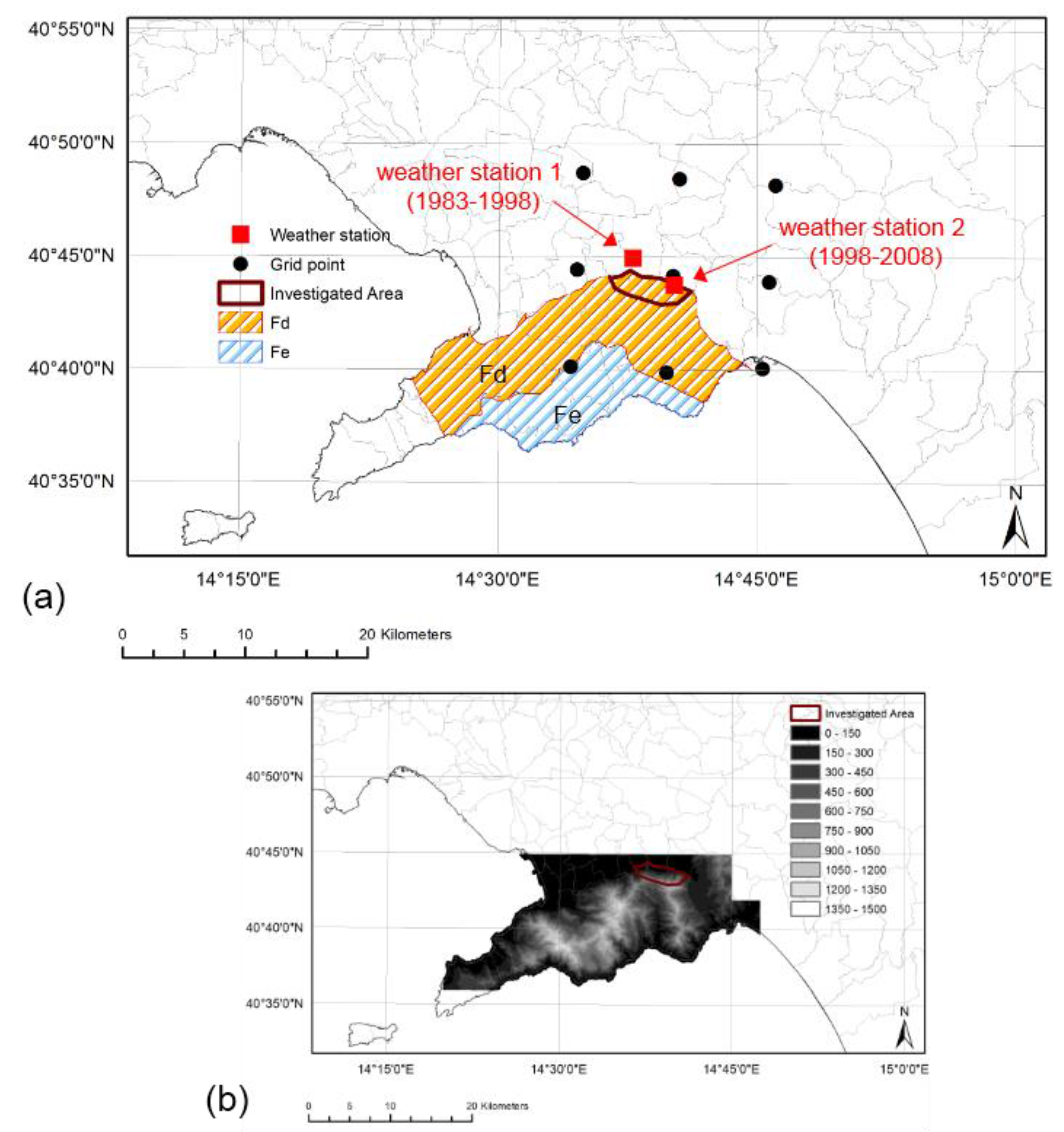
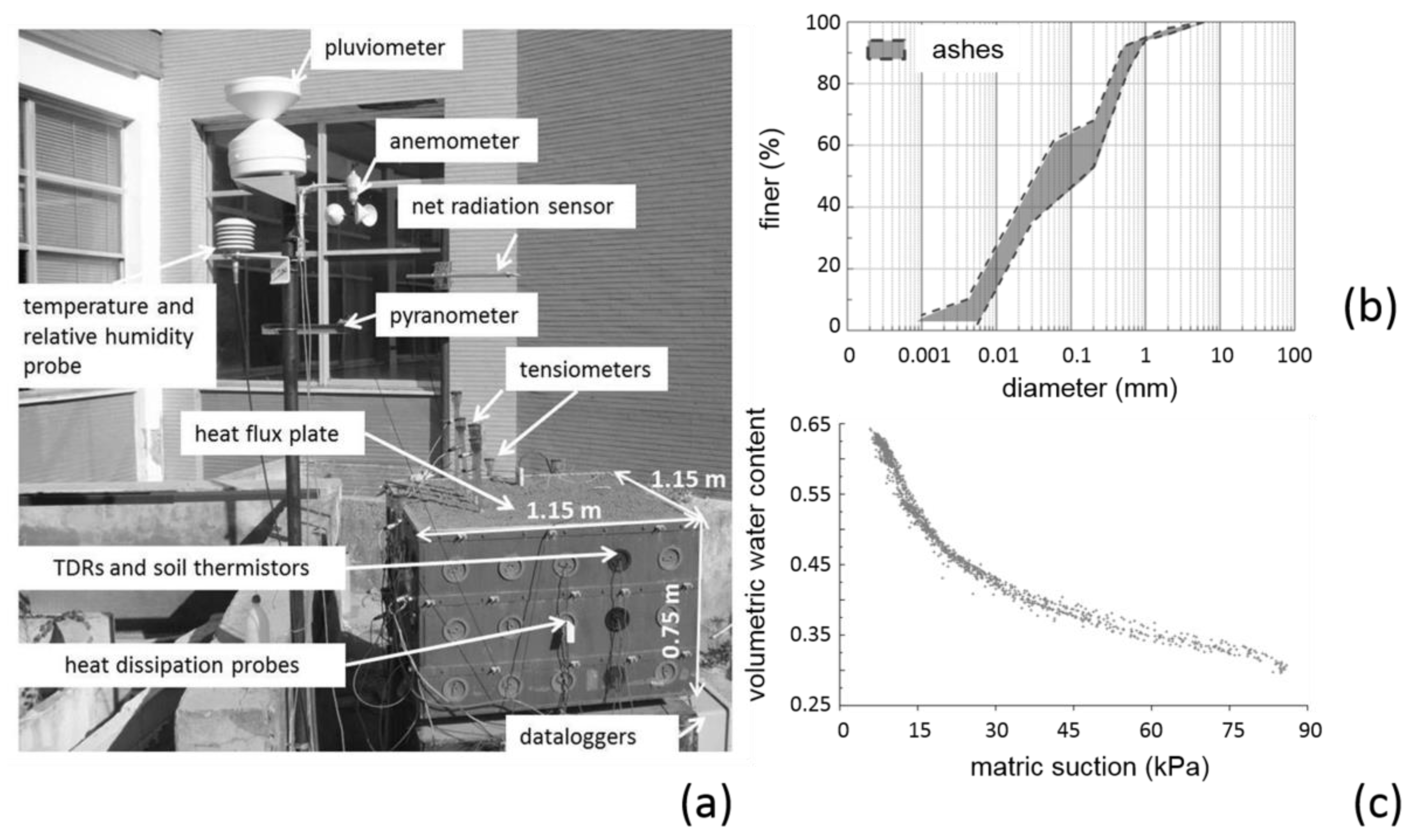
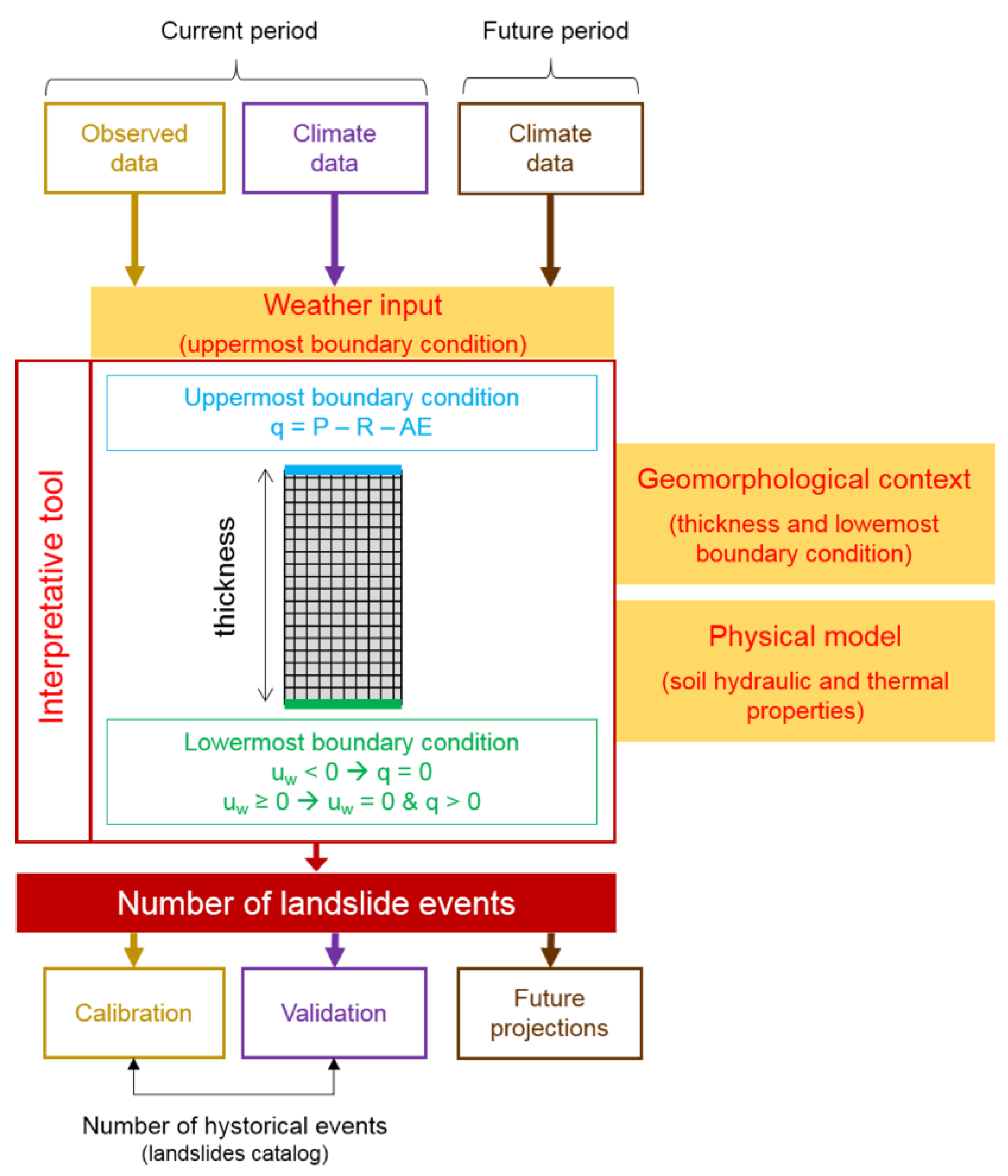
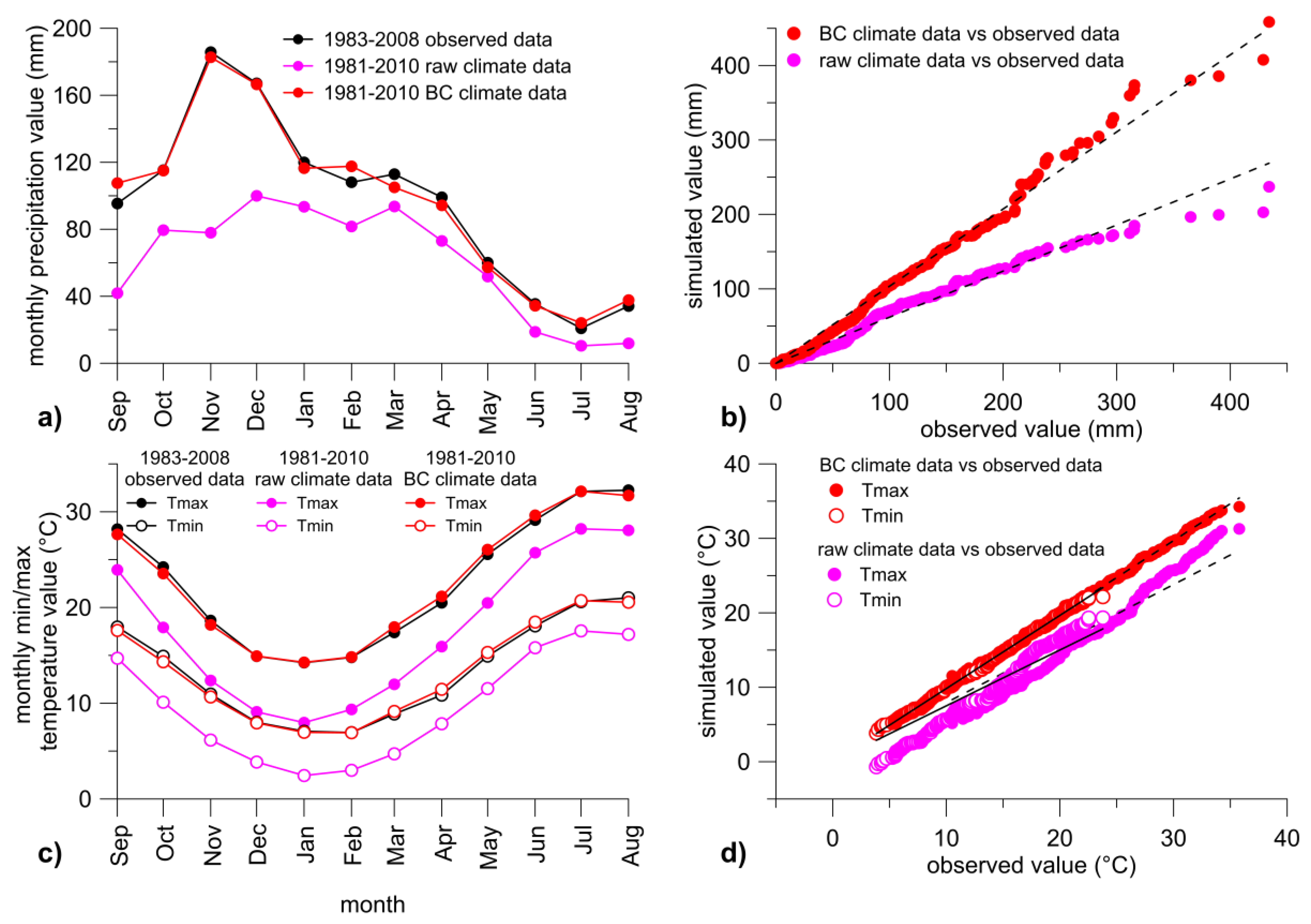
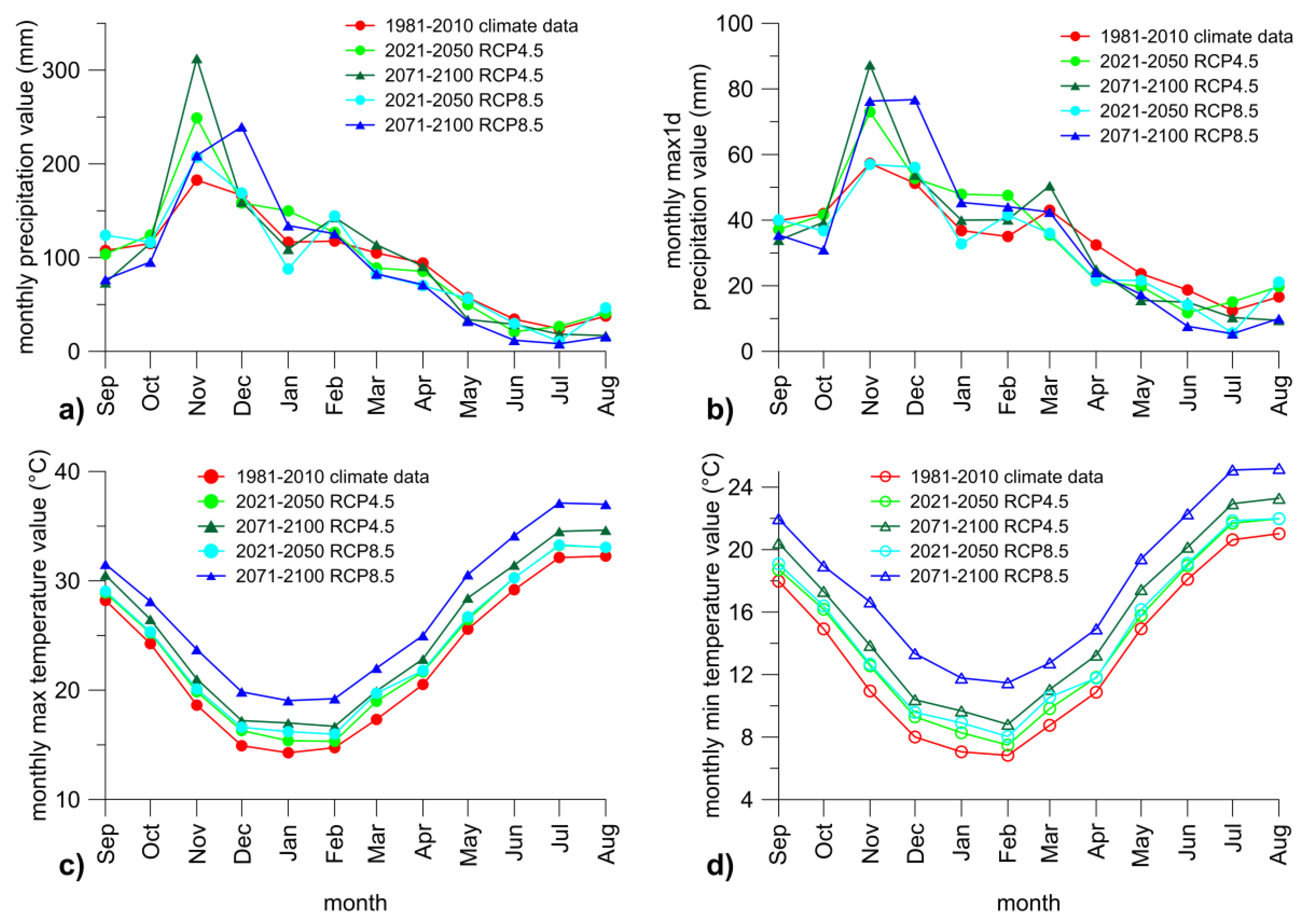


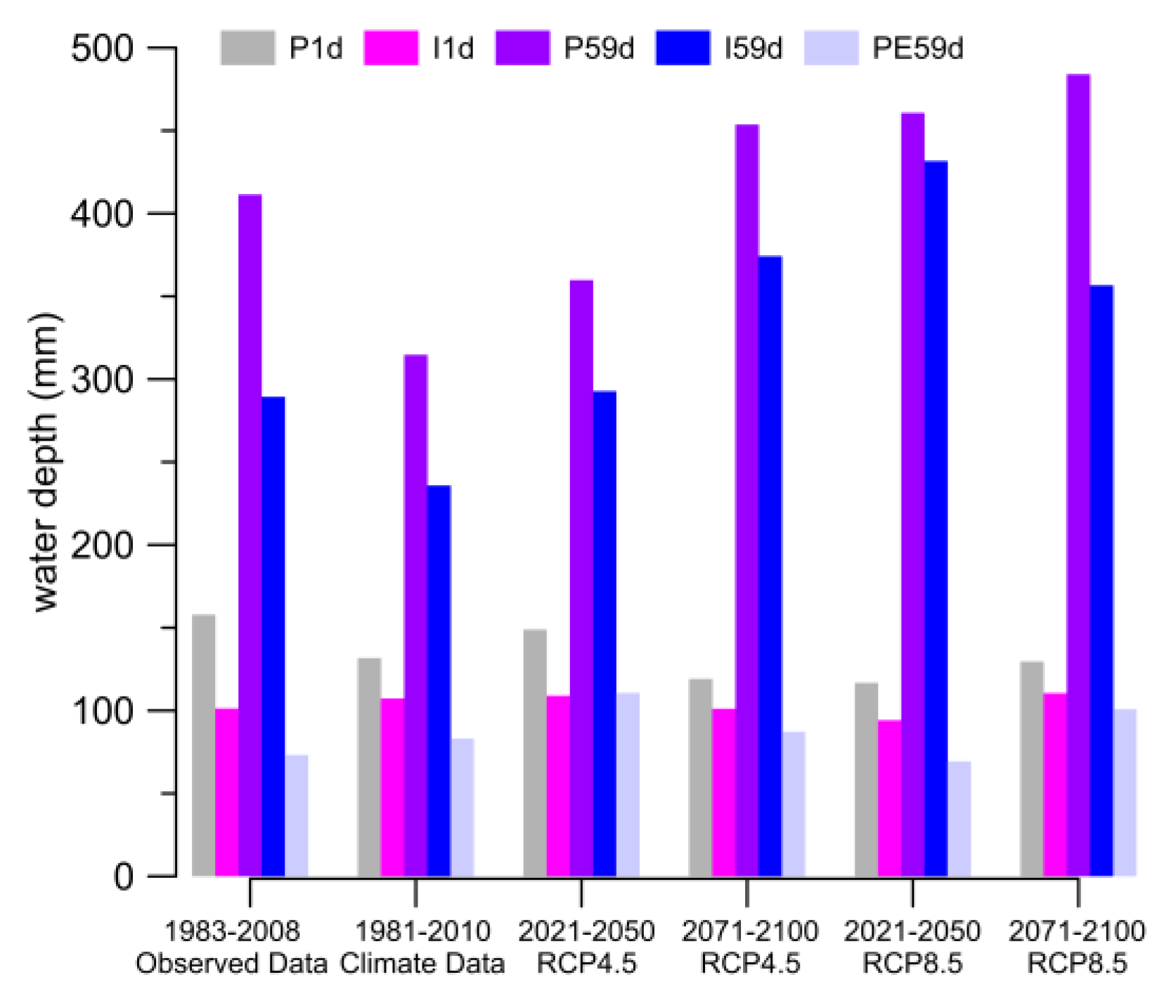

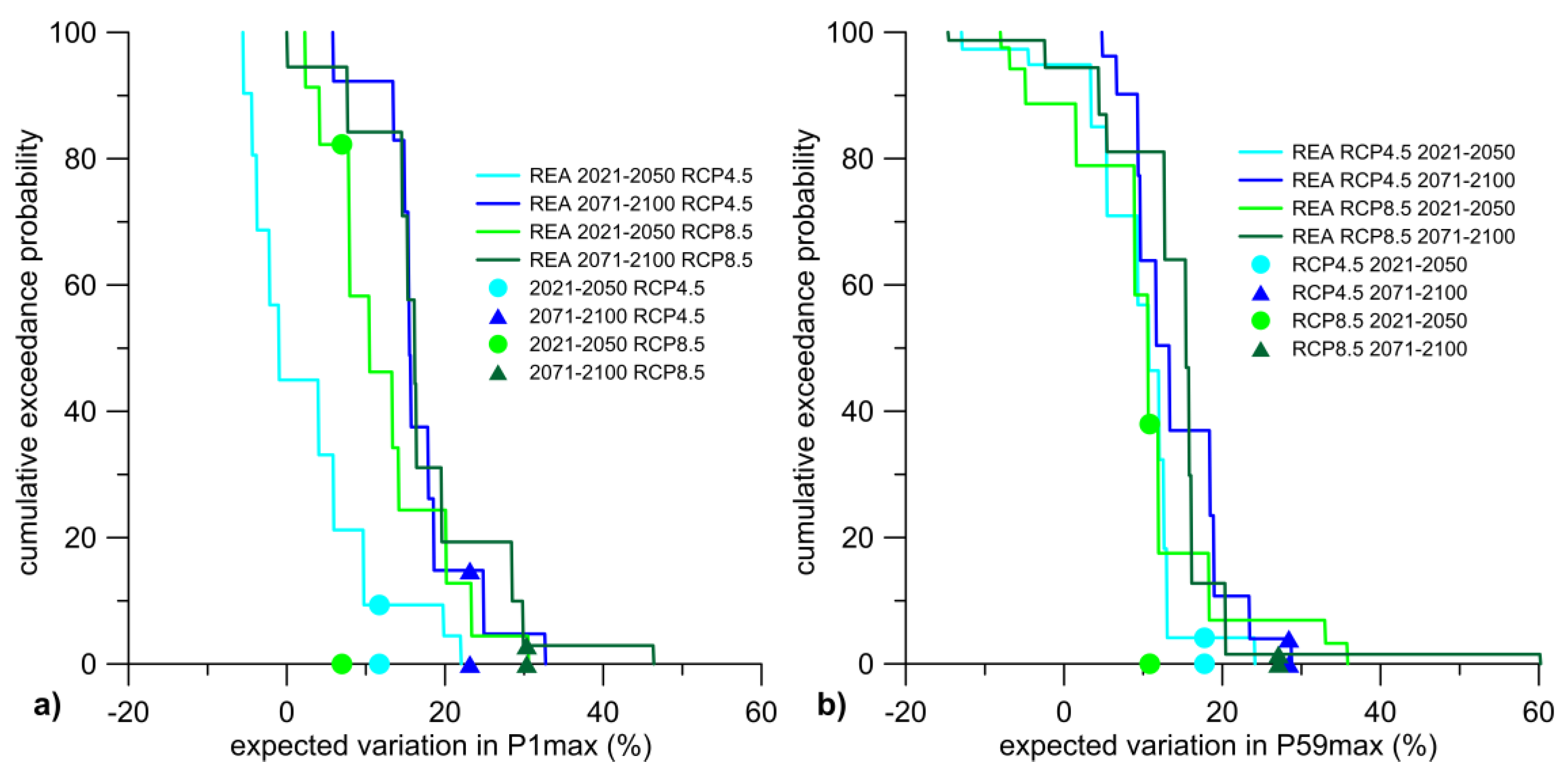
| Dataset | Time Horizon |
|---|---|
| Observed data (data available over 1983–2008) | 1981–2010 |
| Simulated climate data over current period | 1981–2010 |
| Simulated climate data—RCP4.5 | 2021–2050 |
| Simulated climate data—RCP4.5 | 2071–2100 |
| Simulated climate data—RCP8.5 | 2021–2050 |
| Simulated climate data—RCP8.5 | 2071–2100 |
| Concentration Scenario | Time Horizon | Precipitation Events Exceeding the Threshold | DJF | MAM | JJA | SON | Potential Failure Events |
|---|---|---|---|---|---|---|---|
| RCP4.5 | 2021–2050 | 109 | 50 | 8 | 1 | 50 | 3.11 |
| 2071–2100 | 125 | 51 | 16 | 0 | 58 | 3.57 | |
| RCP8.5 | 2021–2050 | 90 | 49 | 9 | 1 | 31 | 2.57 |
| 2071–2100 | 119 | 72 | 9 | 0 | 38 | 3.40 |
© 2017 by the authors. Licensee MDPI, Basel, Switzerland. This article is an open access article distributed under the terms and conditions of the Creative Commons Attribution (CC BY) license (http://creativecommons.org/licenses/by/4.0/).
Share and Cite
Rianna, G.; Reder, A.; Mercogliano, P.; Pagano, L. Evaluation of Variations in Frequency of Landslide Events Affecting Pyroclastic Covers in Campania Region under the Effect of Climate Changes. Hydrology 2017, 4, 34. https://doi.org/10.3390/hydrology4030034
Rianna G, Reder A, Mercogliano P, Pagano L. Evaluation of Variations in Frequency of Landslide Events Affecting Pyroclastic Covers in Campania Region under the Effect of Climate Changes. Hydrology. 2017; 4(3):34. https://doi.org/10.3390/hydrology4030034
Chicago/Turabian StyleRianna, Guido, Alfredo Reder, Paola Mercogliano, and Luca Pagano. 2017. "Evaluation of Variations in Frequency of Landslide Events Affecting Pyroclastic Covers in Campania Region under the Effect of Climate Changes" Hydrology 4, no. 3: 34. https://doi.org/10.3390/hydrology4030034






